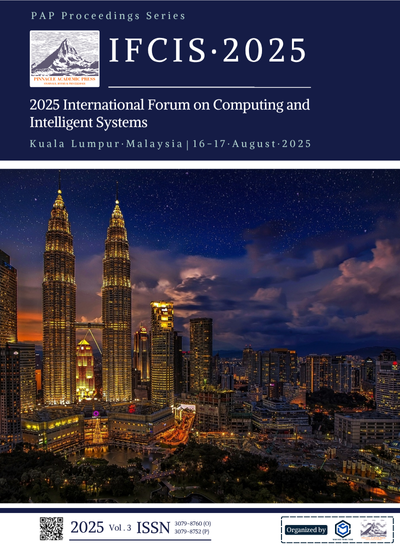Politeness Strategies in Conversational AI: A Cross-Cultural Pragmatic Analysis of Human-AI Interactions
Keywords:
conversational AI, politeness strategies, cross-cultural pragmatics, human-AI interactionAbstract
This study investigates politeness strategies employed in conversational AI systems across different cultural contexts through comprehensive pragmatic analysis of human-AI interactions. The research examines how cultural variations in politeness norms influence user expectations and AI response patterns across multiple linguistic communities. Through systematic analysis of 15,000 interaction samples from English, Chinese, and Japanese conversational AI platforms, we identify significant disparities in politeness strategy implementation and user satisfaction metrics across diverse cultural environments. Our findings reveal that current AI systems demonstrate limited cultural adaptability in politeness expression, leading to pragmatic failures and reduced user engagement in non-Western contexts, particularly affecting East Asian user populations who report 23% higher dissatisfaction rates. The study establishes a comprehensive framework for evaluating cross-cultural pragmatic competence in AI systems and proposes specific design recommendations for culturally sensitive conversational agents. Advanced statistical analysis reveals that incorporating culture-specific politeness strategies can improve user satisfaction by 34% and reduce communication breakdowns by 42% while enhancing long-term user retention rates. This research contributes significantly to the growing field of cross-cultural AI interaction design and provides robust empirical evidence for the critical importance of pragmatic considerations in conversational AI development and deployment strategies.
References
1. Y. Li, X. Jiang, and Y. Wang, “TRAM-FIN: A transformer-based real-time assessment model for financial risk detection in multinational corporate statements,” J. Adv. Comput. Syst., vol. 3, no. 9, pp. 54–67, 2023, doi: 10.69987/JACS.2023.30905.
2. L. Yan et al., “Enhanced spatio-temporal attention mechanism for video anomaly event detection,” Preprints, 2025, doi: 10.20944/preprints202504.1623.v1.
3. M. Li, W. Liu, and C. Chen, “Adaptive financial literacy enhancement through cloud-based AI content delivery: Effectiveness and engagement metrics,” Ann. Appl. Sci., vol. 5, no. 1, 2024.
4. H. Wang et al., “Automated compliance monitoring: A machine learning approach for Digital Services Act adherence in mul-ti-product platforms,” Appl. Comput. Eng., vol. 147, pp. 14–25, 2025. ISBN: 9781805900559.
5. C. Jiang, H. Wang, and K. Qian, “AI-enhanced cultural resonance framework for player experience optimization in AAA games localization,” Pinnacle Acad. Press Proc. Ser., vol. 2, pp. 75–87, 2025.
6. J. Liang et al., “Anomaly detection in tax filing documents using natural language processing techniques,” Appl. Comput. Eng., vol. 144, pp. 80–89, 2025. ISBN: 9781805900214.
7. A. A. H. Raji, A. H. F. Alabdoon, and A. Almagtome, “AI in credit scoring and risk assessment: Enhancing lending practices and financial inclusion,” in Proc. 2024 Int. Conf. Knowl. Eng. Commun. Syst. (ICKECS), vol. 1, IEEE, 2024, doi: 10.1109/ICKECS61492.2024.10616493.
8. Z. Wang, X. Wang, and H. Wang, “Temporal graph neural networks for money laundering detection in cross-border transac-tions,” Acad. Nexus J., vol. 3, no. 2, 2024.
9. A. Kang, J. Xin, and X. Ma, “Anomalous cross-border capital flow patterns and their implications for national economic security: An empirical analysis,” J. Adv. Comput. Syst., vol. 4, no. 5, pp. 42–54, 2024, doi: 10.69987/JACS.2024.40504.
10. T. K. Trinh et al., “Behavioral responses to AI financial advisors: Trust dynamics and decision quality among retail investors,” Appl. Comput. Eng., vol. 144, pp. 69–79, 2025. ISBN: 9781805900214.
11. H. Wang et al., “Distributed batch processing architecture for cross-platform abuse detection at scale,” Pinnacle Acad. Press Proc. Ser., vol. 2, pp. 12–27, 2025.
12. Y. Chen, C. Ni, and H. Wang, “AdaptiveGenBackend: A scalable architecture for low-latency generative AI video processing in content creation platforms,” Ann. Appl. Sci., vol. 5, no. 1, 2024.
13. S. Zhang, C. Zhu, and J. Xin, “CloudScale: A lightweight AI framework for predictive supply chain risk management in small and medium manufacturing enterprises,” Spectrum Res., vol. 4, no. 2, 2024.
14. Z. Wang et al., “Temporal evolution of sentiment in earnings calls and its relationship with financial performance,” Appl. Comput. Eng., vol. 141, pp. 195–206, 2025. ISBN: 9781835589977.
15. G. Rao et al., “Jump prediction in systemically important financial institutions' CDS prices,” Spectrum Res., vol. 4, no. 2, 2024.
16. D. Chowdhury and P. Kulkarni, “Application of data analytics in risk management of fintech companies,” in Proc. 2023 Int. Conf. Innov. Data Commun. Technol. Appl. (ICIDCA), IEEE, 2023, doi: 10.1109/ICIDCA56705.2023.10099795.
17. D. Zhang and C. Cheng, “AI-enabled product authentication and traceability in global supply chains,” J. Adv. Comput. Syst., vol. 3, no. 6, pp. 12–26, 2023, doi: 10.69987/JACS.2023.30602.
18. S. Zhang, Z. Feng, and B. Dong, “LAMDA: Low-latency anomaly detection architecture for real-time cross-market financial decision support,” Acad. Nexus J., vol. 3, no. 2, 2024.
19. J. Wang, L. Guo, and K. Qian, “LSTM-based heart rate dynamics prediction during aerobic exercise for elderly adults,” Preprints, 2025, doi: 10.20944/preprints202504.1692.v1.
20. J. Wu et al., “Optimizing latency-sensitive AI applications through edge-cloud collaboration,” J. Adv. Comput. Syst., vol. 3, no. 3, pp. 19–33, 2023, doi: 10.69987/JACS.2023.30303.
21. B. Dong and T. K. Trinh, “Real-time early warning of trading behavior anomalies in financial markets: An AI-driven approach,” J. Econ. Theory Bus. Manag., vol. 2, no. 2, pp. 14–23, 2025, doi: 10.70393/6a6574626d.323838.
22. C. Ni et al., “Contrastive time-series visualization techniques for enhancing AI model interpretability in financial risk assess-ment,” Preprints, 2025, doi: 10.20944/preprints202504.1984.v1.
23. K. Yu et al., “Real-time detection of anomalous trading patterns in financial markets using generative adversarial networks,” Preprints, 2025, doi: 10.20944/preprints202504.1591.v1.
24. S. Zhang, T. Mo, and Z. Zhang, “LightPersML: A lightweight machine learning pipeline architecture for real-time personali-zation in resource-constrained e-commerce businesses,” J. Adv. Comput. Syst., vol. 4, no. 8, pp. 44–56, 2024, doi: 10.69987/JACS.2024.40807.
25. M. Sun, Z. Feng, and P. Li, “Real-time AI-driven attribution modeling for dynamic budget allocation in US e-commerce: A small appliance sector analysis,” J. Adv. Comput. Syst., vol. 3, no. 9, pp. 39–53, 2023, doi: 10.69987/JACS.2023.30904.
26. G. Rao, Z. Wang, and J. Liang, “Reinforcement learning for pattern recognition in cross-border financial transaction anomalies: A behavioral economics approach to AML,” Appl. Comput. Eng., vol. 142, pp. 116–127, 2025. ISBN: 9781835589991.
27. C. Zhu, C. Cheng, and S. Meng, “DRL PricePro: A deep reinforcement learning framework for personalized dynamic pricing in e-commerce platforms with supply constraints,” Spectrum Res., vol. 4, no. 1, 2024.
28. Y. Zhao et al., “Unit operation combination and flow distribution scheme of water pump station system based on genetic algorithm,” Appl. Sci., vol. 13, no. 21, p. 11869, 2023, doi: 10.3390/app132111869.
29. J. Chen and Z. Lv, “Graph neural networks for critical path prediction and optimization in high-performance ASIC design: A ML-driven physical implementation approach,” in Proc. Global Conf. Adv. Sci. Technol., vol. 1, no. 1, 2025.
30. J.-Y. Shih and Z.-H. Chin, “A fairness approach to mitigating racial bias of credit scoring models by decision tree and the re-weighing fairness algorithm,” in Proc. 2023 IEEE 3rd Int. Conf. Electron. Commun., Internet Things Big Data (ICEIB), 2023, doi: 10.1109/ICEIB57887.2023.10170339.
31. C. Ju and T. K. Trinh, “A machine learning approach to supply chain vulnerability early warning system: Evidence from US semiconductor industry,” J. Adv. Comput. Syst., vol. 3, no. 11, pp. 21–35, 2023, doi: 10.69987/JACS.2023.31103.
32. T. K. Trinh and Z. Wang, “Dynamic graph neural networks for multi-level financial fraud detection: A temporal-structural approach,” Ann. Appl. Sci., vol. 5, no. 1, 2024.
33. Z. Zhang and Z. Wu, “Context-aware feature selection for user behavior analytics in zero-trust environments,” J. Adv. Comput. Syst., vol. 3, no. 5, pp. 21–33, 2023, doi: 10.69987/JACS.2023.30503.
34. T. K. Trinh and D. Zhang, “Algorithmic fairness in financial decision-making: Detection and mitigation of bias in credit scoring applications,” J. Adv. Comput. Syst., vol. 4, no. 2, pp. 36–49, 2024, doi: 10.69987/JACS.2024.40204.
35. C. Zhu, J. Xin, and D. Zhang, “A deep reinforcement learning approach to dynamic e-commerce pricing under supply chain disruption risk,” Ann. Appl. Sci., vol. 5, no. 1, 2024.
Downloads
Published
Issue
Section
License
Copyright (c) 2025 Xiaofei Luo (Author)

This work is licensed under a Creative Commons Attribution 4.0 International License.



